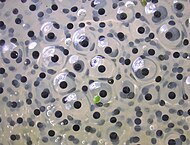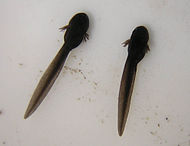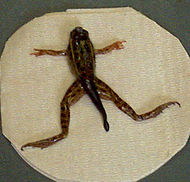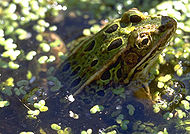m (W126jep moved page Adventist Youth Honors Answer Book/Nature/Life cycle of a frog to AY Honors/Life cycle of a frog without leaving a redirect: Part of translatable page "Adventist Youth Honors Answer Book/Nature/Life cycle of a frog") |
|||
| (450 intermediate revisions by 45 users not shown) | |||
| Line 1: | Line 1: | ||
| − | + | <noinclude><translate></noinclude> | |
| − | + | ===Frogs=== <!--T:1--> | |
| − | + | [[Image:Frogspawn closeup.jpg|190px|thumb|Frogspawn]] | |
| − | + | [[Image:Tadpoles 10 days.jpg|190px|thumb||10 days: Tadpoles]] | |
| − | + | [[Image:Frog-Zhe.jpg||190px|thumb|8–12 weeks: Froglet]] | |
| − | + | [[Image:Green-leopard-frog-in-swamp.jpg||190px|thumb|12–16 weeks: Adult frog]] | |
| − | + | The life cycle of frogs, like that of other amphibians, consists of four main stages: egg, tadpole, metamorphosis and adult. The reliance of frogs on an aquatic environment for the egg and tadpole stages gives rise to a variety of breeding behaviors that include the well-known mating calls used by the males of most species to attract females to the bodies of water that they have chosen for breeding. Some frogs also look after their eggs—and in some cases even the tadpoles—for some time after laying. | |
| − | |||
| − | |||
| − | |||
| − | |||
| − | [[ | ||
| − | |||
| − | - | ||
| − | |||
| − | |||
| − | + | <!--T:2--> | |
| + | The life cycle of a frog starts with an egg. Eggs are generally laid in water, and an individual female may lay egg masses containing thousands of eggs. While the length of the egg stage depends on the species and environmental conditions, aquatic eggs generally hatch within one week. | ||
| + | <!--T:3--> | ||
| + | Some frogs do not have the tadpole stage going from egg to adult shape e.g. New Zealand's native frogs (pepeketua) belong to the genus Leiopelma. | ||
| + | Eggs hatch and continue life as tadpoles (occasionally known as polliwogs). Tadpoles are aquatic, lack front and hind legs, and have gills for breathing and tails with fins for swimming. Tadpoles are typically herbivorous, feeding mostly on algae, including diatoms that are filtered from the water through the gills. Some species are carnivorous at the tadpole stage, eating insects, smaller tadpoles and fish. The tadpole stage may be as short as a week, or tadpoles may overwinter and metamorphosis the following year in some species, such as the Midwife toad (''Alytes obstetricans'') and the Common Spadefoot (''Pelobates fuscus''). | ||
| − | + | <!--T:4--> | |
| − | + | At the end of the tadpole stage, frogs undergo metamorphosis, in which they transition into adult form. Metamorphosis involves a dramatic transformation of body shape and function, as tadpoles develop hind legs and then front legs, lose their gills and develop lungs. Their intestines shorten as they shift from an herbivorous to a carnivorous diet. The final stage of development from froglet to adult frog involves the loss of the tail. | |
| − | + | <!--T:5--> | |
| − | + | After metamorphosis, young adults may leave the water and disperse into terrestrial habitats, or continue to live in the aquatic habitat as adults. Almost all species of frogs are carnivores as adults, eating invertebrates such as spiders, insects, snails, and slugs. A few of the larger species may eat prey such as small mammals, fish and smaller frogs. Some frogs use their sticky tongues to catch fast-moving prey, while others capture their prey and force it into their mouths with their hands. However, there are a very few species of frogs that primarily eat plants. Adult frogs are themselves preyed upon by birds, large fish, snakes, otters, foxes, badgers, coatis, and other animals. | |
| − | + | <br style="clear:both"> | |
| − | + | <noinclude></translate></noinclude> | |
| − | + | [[Category:Adventist Youth Honors Answer Book|{{SUBPAGENAME}}]] | |
| − | |||
| − | |||
| − | |||
| − | |||
| − | |||
| − | |||
| − | |||
| − | |||
| − | |||
| − | |||
| − | |||
| − | |||
| − | |||
| − | |||
| − | |||
| − | |||
| − | |||
| − | |||
| − | |||
| − | |||
| − | |||
| − | |||
| − | |||
| − | |||
| − | |||
| − | |||
| − | |||
| − | [[Category: | ||
| − | |||
| − | {{ | ||
| − | |||
| − | |||
| − | |||
| − | |||
| − | |||
| − | |||
| − | |||
| − | |||
| − | |||
| − | |||
| − | |||
| − | |||
| − | |||
| − | |||
| − | |||
| − | |||
| − | |||
| − | |||
| − | |||
| − | |||
| − | |||
Latest revision as of 14:26, 21 September 2021
Frogs
The life cycle of frogs, like that of other amphibians, consists of four main stages: egg, tadpole, metamorphosis and adult. The reliance of frogs on an aquatic environment for the egg and tadpole stages gives rise to a variety of breeding behaviors that include the well-known mating calls used by the males of most species to attract females to the bodies of water that they have chosen for breeding. Some frogs also look after their eggs—and in some cases even the tadpoles—for some time after laying.
The life cycle of a frog starts with an egg. Eggs are generally laid in water, and an individual female may lay egg masses containing thousands of eggs. While the length of the egg stage depends on the species and environmental conditions, aquatic eggs generally hatch within one week.
Some frogs do not have the tadpole stage going from egg to adult shape e.g. New Zealand's native frogs (pepeketua) belong to the genus Leiopelma. Eggs hatch and continue life as tadpoles (occasionally known as polliwogs). Tadpoles are aquatic, lack front and hind legs, and have gills for breathing and tails with fins for swimming. Tadpoles are typically herbivorous, feeding mostly on algae, including diatoms that are filtered from the water through the gills. Some species are carnivorous at the tadpole stage, eating insects, smaller tadpoles and fish. The tadpole stage may be as short as a week, or tadpoles may overwinter and metamorphosis the following year in some species, such as the Midwife toad (Alytes obstetricans) and the Common Spadefoot (Pelobates fuscus).
At the end of the tadpole stage, frogs undergo metamorphosis, in which they transition into adult form. Metamorphosis involves a dramatic transformation of body shape and function, as tadpoles develop hind legs and then front legs, lose their gills and develop lungs. Their intestines shorten as they shift from an herbivorous to a carnivorous diet. The final stage of development from froglet to adult frog involves the loss of the tail.
After metamorphosis, young adults may leave the water and disperse into terrestrial habitats, or continue to live in the aquatic habitat as adults. Almost all species of frogs are carnivores as adults, eating invertebrates such as spiders, insects, snails, and slugs. A few of the larger species may eat prey such as small mammals, fish and smaller frogs. Some frogs use their sticky tongues to catch fast-moving prey, while others capture their prey and force it into their mouths with their hands. However, there are a very few species of frogs that primarily eat plants. Adult frogs are themselves preyed upon by birds, large fish, snakes, otters, foxes, badgers, coatis, and other animals.




